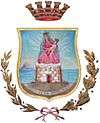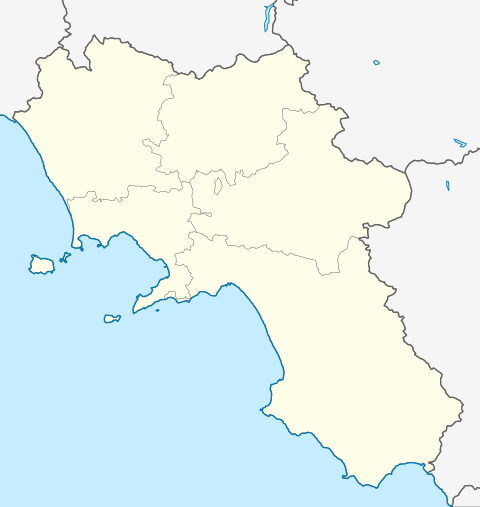Castellammare di Stabia
Castellammare di Stabia (Italian: [kaˌstɛllamˈmaːre di ˈstaːbja]; Neapolitan: Castiellammare 'e Stabbia) is a comune in the Metropolitan City of Naples, Campania region, in Italy. It is situated on the Bay of Naples about 30 kilometres (19 miles) southeast of Naples, on the route to Sorrento.
Castellammare di Stabia Castiellammare 'e Stabbia | |
|---|---|
Castellammare di Stabia with the Gulf of Naples and the Vesuvio | |
 Coat of arms | |
.svg.png) Castellammare within the Metropolitan City of Naples | |
Location of Castellammare di Stabia 
| |
 Castellammare di Stabia Location of Castellammare di Stabia in Italy  Castellammare di Stabia Castellammare di Stabia (Campania) | |
| Coordinates: 40°42′N 14°29′E | |
| Country | Italy |
| Region | Campania |
| Metropolitan city | Naples (NA) |
| Frazioni | Fratte, Madonna della Libera, Pioppaino, Ponte Persica, Pozzano, Privati, Quisisana, Scanzano, Varano |
| Government | |
| • Mayor | Gaetano Cimmino |
| Area | |
| • Total | 17.71 km2 (6.84 sq mi) |
| Elevation | 6 m (20 ft) |
| Population (1 January 2017)[2] | |
| • Total | 66,164 |
| • Density | 3,700/km2 (9,700/sq mi) |
| Demonym(s) | Stabiesi |
| Time zone | UTC+1 (CET) |
| • Summer (DST) | UTC+2 (CEST) |
| Postal code | 80053 |
| Dialing code | 081 |
| Patron saint | Saint Catellus |
| Saint day | 19 January |
| Website | Official website |
History
Castellammare di Stabia lies next to the ancient Roman city of Stabiae, which was destroyed by the Vesuvio eruption in A.D. 79. The castle, of the city it takes its name from, was erected around the 9th century on a hill commanding the southern side of the Gulf of Naples. It was restored during the reign of Frederick II of Hohenstaufen and enlarged by King Charles I of Anjou.
The comune, previously called Castellamare, assumed the name Castellammare on 22 January 1863, and the current name on 31 May 1912.
Religious buildings
- Castellammare Cathedral
- San Bartolomeo
- Santa Caterina
- Chiesa del Gesù
- Chiesa del Purgatorio
Excavation of villas
The excavation of Roman villas preserved by the eruption of Vesuvius in AD 79 is currently underway. Villa Arianna and Villa San Marco can be visited and do not charge for admission.
The thermal baths
Castellammare is known as the Metropole of the waters for its hydrological heritage of 28 different kinds of waters, divided in sulphurous, calcic bicarbonate and mineral water, each one with a particular healthy property. The thermal bath has been a huge part of the economic life as well as of the tourism of Castellammare since the XIX century. To take advantage of the waters’ property there are two different thermal baths, one in the historical centre of the town and the other on the hill. Besides, the two most important waters of Castellammare, Acqua della Madonna and Acetosella, have been know since the time of Pliny the Elder, who suggested to drink them in case of calculosis, today they are sold as far away as America.
The ancient thermal baths
The Ancient Thermal Baths were inaugurated in 1836 and since the beginning had a very important role for the citizens and also for the tourists coming in summer for the thermal cure, making the city very crowded. Because of this overcrowding the building was enlarged with new pavilions and pools for the thermal cures of the body, like a real spa but it was also a cultural centre where many art exhibitions, cultural events and concerts were held. On 26 February 1956 began the destruction of the ancient building to make way for today's building. At the end of the 1980s the thermal building was in crisis because most of its offered treatments were closed, even if today they are offered in the New Thermal Baths. Today the Ancient Baths opens only few hours a day for bathing. In summer there are some cultural events. In the summer of 2007 the renovation of the building began so it can resume the many thermal services.
The new thermal baths
The New Thermal Baths, located on the hill of the Solaro, near the district of Scanzano, was inaugurated on 26 July 1964. This building has two zones: one zone is the building dedicated to the thermal cure and then there is the park for the hydroponic cure. The building for the thermal cure offers the chance of practicing physiotherapy, hyperbaric medicine, massages, mud baths, inhalation of the sulphurous waters, rehabilitating, dermatological, aesthetic and gynaecological cures. Instead the hydroponic park allows practicing hydrotherapy, that is drinking the specific kind of water to cure specific pathologies, while walking through the park. Moreover, in summer in the park there are many events, during mornings and evenings, such as concerts, open cinema, exhibitions and conventions.
Geography
Castellammare borders with the municipalities of Gragnano, Pimonte, Pompei, Santa Maria la Carità, Torre Annunziata and Vico Equense.[3]
It counts the hamlets (frazioni) of Fratte, Madonna della Libera, Pioppaino, Ponte Persica, Pozzano, Privati, Quisisana, Scanzano and Varano.
Sport
The local football team, SS Juve Stabia, currently plays in Italian Serie B and is one of the oldest football teams in Italy, having been created in 1907. SS Juve Stabia plays its matches in Romeo Menti Stadium.
People
- Pliny the Elder, born Gaius Plinius Secundus (AD 23 – 25 August, AD 79), adoptive citizen and resident of Stabiae (ancient name of Castellammare di Stabia), where he died during the 25 August, AD 79 Mt. Vesuvius eruption. Roman author, naturalist, and natural philosopher, as well as naval and army commander of the early Roman Empire, and personal friend of the emperor Vespasian.
- Catello, Saint (9th century), Patron of the city
- Giuseppe Bonito (1707–1789), painter
- Nikolai Gogol (1809–1852) worked here on his Dead Souls in 1838, while living at the count Repnin's summer house.
- Luigi Denza (1846–1922), composer of the most famous Italian traditional song Funiculì, Funiculà
- Michele Esposito (1855–1929), influential composer, pianist, conductor, who worked mostly in Ireland
- Ettore Tito (1859–1941), painter
- Raffaele Viviani (1888–1950), author, playwright, actor, musician
- John Serry, Sr. (1915–2003; aka Giovanni Serrapica) American musician, composer, arranger, educator
- Gabriele De Rosa (1917–2009), historian and politician
- Marcel Jovine (1921–2003), sculptor and toy designer
- Mario Merola (1934–2006), Neapolitan-style singer
- Giuseppe (1959) and Carmine Abbagnale (1962), Olympic gold medal rowers, grown up and trained at the Castellammare Yachting Club
- Gennaro Iezzo (born 1973), football goalkeeper
- Bruno Cirillo (born 1977), footballer
- Antonio Mirante (born 1983), footballer
- Fabio Quagliarella (born 1983), footballer
- Luigi Vitale (born 1987), footballer
- Antonio Donnarumma (born 1990) A.C. Milan goalkeeper, older brother of Gianluigi Donnarumma
- Gianluigi Donnarumma (born 1999), A.C. Milan goalkeeper, second-youngest goalkeeper to play in Serie A
- Sebastiano Esposito (born 2002) Inter Milan striker
See also
References
- "Superficie di Comuni Province e Regioni italiane al 9 ottobre 2011". Istat. Retrieved 16 March 2019.
- (in Italian) All demographics and other statistics: Italian statistical institute Istat.
- 40689 Castellammare di Stabia on OpenStreetMap
External links
| Wikisource has the text of the 1911 Encyclopædia Britannica article Castellammare di Stabia. |
| Wikimedia Commons has media related to Castellammare di Stabia. |
- Castellammare di Stabia official website (in Italian)
